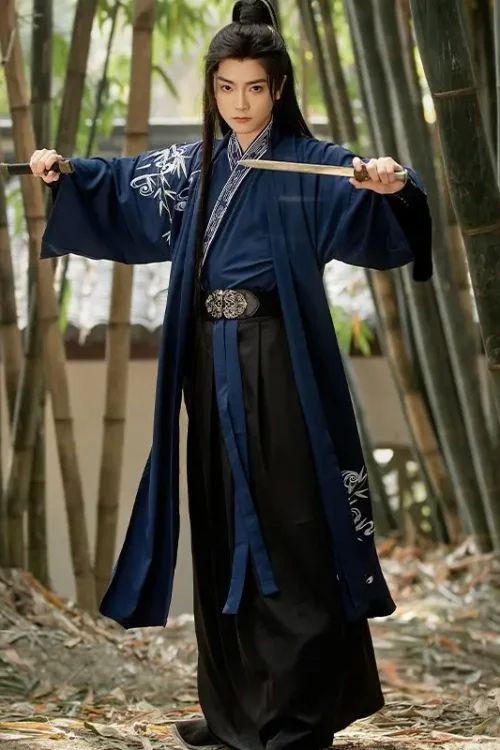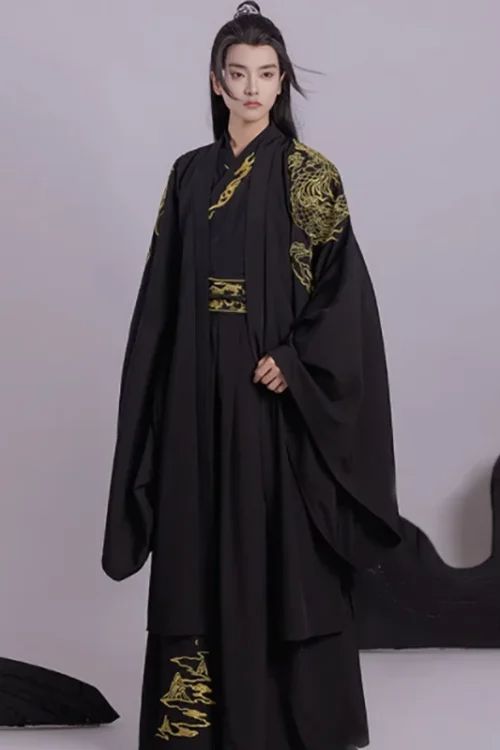Hanfu: A Historical Perspective on Masculinity in Chinese Fashion
Hanfu, the traditional attire of the Han Chinese, has historically played a significant role in shaping societal norms and perceptions of masculinity. In ancient China, Hanfu was not merely a garment but an embodiment of cultural values and social hierarchy. For men, Hanfu served as a symbol of authority, status, and refinement.

The Han Dynasty: Symbols of Power and Authority
During the Han dynasty (206 BCE – 220 CE), Hanfu for men consisted of a long, flowing robe known as a “changpao” and a wide-sleeved jacket called a “shenyi.” These vestuário were often adorned with intricate embroidery and jade ornaments, reflecting the wearer’s wealth and social standing. The changpao, in particular, symbolized power and authority, as it was worn by officials and scholars.
The Tang Dynasty: A Shift in Style
As Chinese society evolved, so did the styles and meanings associated with Hanfu. During the Tang dynasty (618 – 907 CE), Hanfu for men became more elaborate and flamboyant. The changpao was replaced by a shorter, more fitted robe called a “zhiju,” which allowed for greater freedom of movement. This shift reflected the Tang dynasty’s emphasis on martial arts and physical prowess.
The Song Dynasty: Emphasis on Modesty and Refinement
However, with the rise of the Song dynasty (960 – 1279 CE), Hanfu for men underwent a significant transformation. The zhiju was replaced by a more conservative and modest robe known as a “changshan.” This change mirrored the Song dynasty’s focus on Confucian values and intellectual pursuits. The changshan became a symbol of scholarly refinement and moral integrity.
The Decline and Revival of Hanfu
In the centuries that followed, Hanfu gradually fell out of favor as foreign influences and Western fashion gained popularity. However, in recent years, there has been a growing revival of interest in Hanfu, particularly among young Chinese men. This revival is driven by a desire to reconnect with traditional Chinese culture and to challenge prevailing Western fashion norms.
Modern interpretations of Hanfu for men often incorporate contemporary elements while retaining the essence of traditional designs. These garments are worn by men from all walks of life, from students to professionals, and are seen as a symbol of cultural pride and a rejection of narrow definitions of masculinity.
Redefining Masculinity: A Cultural Shift
The revival of Hanfu for men is not merely a fashion trend but a reflection of a broader cultural shift. It represents a growing desire among Chinese men to embrace their cultural heritage and to redefine what it means to be masculine in the 21st century. By challenging traditional Western fashion norms and embracing the rich history of Hanfu, these men are creating a new and inclusive vision of masculinity that celebrates both tradition and modernity.
The Revival of Hanfu: Empowering Men to Embrace Traditional Style
In the realm of fashion, the concept of masculinity has long been defined by rigid norms and expectations. However, the revival of Hanfu, a traditional Chinese garment, is challenging these conventions and empowering men to embrace a more diverse and expressive style.
Hanfu, with its flowing robes, intricate embroidery, and elegant silhouettes, has historically been associated with femininity. However, contemporary interpretations of Hanfu are breaking down these gendered boundaries, allowing men to explore their masculinity in new and unconventional ways.

Cultural Significance and Personal Identity
One of the key factors driving this shift is the growing awareness of Hanfu’s historical significance. As a symbol of Chinese culture and heritage, Hanfu carries a sense of pride and identity for many men. By wearing Hanfu, they not only connect with their cultural roots but also assert their individuality and challenge traditional notions of masculinity.
Moreover, Hanfu’s versatility and adaptability make it an attractive option for men seeking a more expressive and comfortable wardrobe. The loose-fitting robes allow for freedom of movement, while the intricate designs and patterns provide ample opportunities for personal expression.
Building a Community
The revival of Hanfu is also fostering a sense of community among men who share a passion for traditional Chinese culture. Through online forums and social media groups, men connect with like-minded individuals, exchange ideas, and support each other in their exploration of Hanfu.
Furthermore, the growing popularity of Hanfu in popular culture, such as television dramas and fashion magazines, is further normalizing the idea of men wearing traditional garments. This exposure is helping to break down stereotypes and create a more inclusive fashion landscape.
Embracing a New Vision of Masculinity
As Hanfu continues to gain traction, it is not only redefining men’s fashion norms but also challenging societal expectations of masculinity. By embracing traditional Chinese garments, men are demonstrating that masculinity can be expressed in a myriad of ways, embracing both strength and elegance, tradition and modernity.
The revival of Hanfu is a testament to the power of fashion to transcend gender boundaries and empower individuals to express their true selves. As men continue to explore the possibilities of Hanfu, they are not only redefining their own style but also contributing to a more diverse and inclusive fashion culture.
Hanfu and Modern Masculinity: Breaking Gender Stereotypes in Fashion
Hanfu, the traditional attire of the Han Chinese, has historically been associated with femininity and elegance. However, in recent years, a growing number of men have embraced Hanfu, challenging conventional notions of masculinity and redefining men’s fashion norms.

Reconnecting with Cultural Heritage
This trend is driven by a desire to reconnect with Chinese cultural heritage and to express a more nuanced and inclusive understanding of masculinity. Hanfu, with its intricate designs, flowing fabrics, and rich symbolism, offers men an alternative to the often restrictive and stereotyped roupas options available to them.
A Broader Societal Shift
Moreover, the revival of Hanfu has coincided with a broader societal shift towards greater gender equality and fluidity. Men are increasingly seeking ways to express their individuality and to break free from traditional gender roles. Hanfu provides a platform for them to do so, allowing them to explore their own masculinity and to challenge societal expectations.
Expanding Definitions of Masculinity
The adoption of Hanfu by men has also sparked a dialogue about the nature of masculinity itself. It has led to a recognition that masculinity is not a monolithic concept but rather a spectrum that encompasses a wide range of expressions. Hanfu, with its emphasis on beauty, grace, and cultural heritage, challenges the narrow and often toxic definitions of masculinity that have prevailed in the past.
Impact on the Fashion Industry
Furthermore, the popularity of Hanfu among men has had a positive impact on the fashion industry. It has inspired designers to create more diverse and inclusive roupas options for men, recognizing that there is a growing demand for vestuário that break away from traditional gender norms.
Conclusion: A Cultural and Social Phenomenon
In conclusion, the embrace of Hanfu by men is a significant cultural and social phenomenon that is redefining men’s fashion norms and challenging conventional notions of masculinity. It is a testament to the power of fashion to transcend gender boundaries and to create a more inclusive and equitable society. As Hanfu continues to gain popularity, it is likely to continue to inspire and empower men to express their individuality and to embrace a more nuanced and authentic understanding of masculinity.
